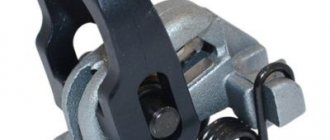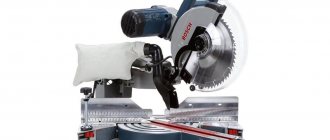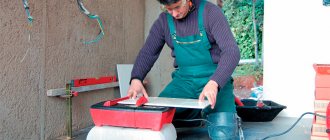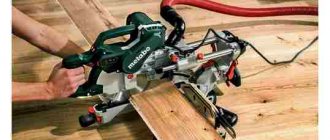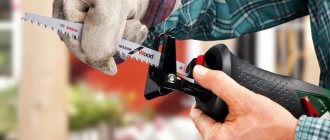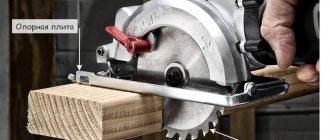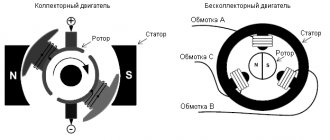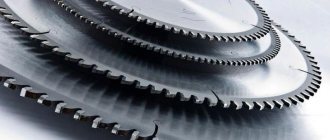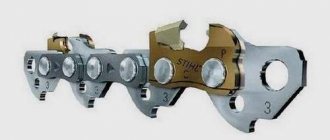Cutting gas blocks can be done with a regular carpenter's hacksaw. However, the length of the standard tool is too short for processing wide blocks. For such work, a special hacksaw with a long base and large teeth is used.
Cutting aerated concrete blocks is a necessary operation that has to be performed during any construction. The dimensions of the partitions are never so well calculated that the blocks can be laid entirely, without adjusting one of them to length. Aerated concrete is placed on an adhesive composition with thin seams, so the quality of the cut must be very high, and the cutting tool must be of high quality and durable. Sometimes you have to cut not in a straight line, or along the block. Such operations, which require high precision and quality of cutting, are performed using specialized tools.
Circulating saws - what are they?
A saw blade, when properly sharpened and set with teeth, is capable of high-quality and accurate sawing of the workpiece in any cutting direction relative to the fibers.
There are several types of cutting blades for a circular saw:
Carbide circular saw - characteristics
- Discs with a base and cutting area made of solid metal;
- Discs with a solid metal base and coating of hard structure materials on the teeth;
- Metal blades with carbide tipped.
High-quality cutting of workpieces is impossible when the teeth are worn out or dull. An accompanying phenomenon of working with a blunt tool will be excessive load on the engine, the risk of jamming, and unsafe cutting operations. Circular saws need to be sharpened.
For cutting hardwood, it is permissible to use only discs that have special grooves. Technological breaks in the blade prevent general deformation of the tool during possible heating during operation. This eliminates the appearance of a vibration background and deterioration of the cut line.
Electric reciprocating saw
Saws of this type are hand-held electric tools, the blades of which perform rotational-translational movements in a horizontal plane. When moving back, the tool blade rises slightly, which makes sawing blocks easier. Externally, a reciprocating saw resembles a jigsaw. Models of this type are equipped with blades with teeth of different sizes and shapes, and can also be battery operated.
The main advantage of this tool is the ease of cutting (both straight and saber). At the same time, the cutting accuracy is several times higher than that of a hand saw.
With the help of reciprocating saws, you can not only cut blocks of the required size, but also make neat grooves for cable networks.
The cost of tools and blades for reciprocating saws depends on the set of additional tools, the power of the units and the manufacturer.
The best manufacturers
The most popular and inexpensive reciprocating saw is the Dewalt DCS380M2 model from an American manufacturer, costing 33,000 rubles. The tool is sold without a blade, so you must additionally purchase foam concrete blades. Their cost will be about 650 rubles (2 pieces). The Dewalt DCS380M2 is lightweight (3.3 kg) and produces 560 watts of power.
It is also worth highlighting cheaper, but no less high-quality models from other manufacturers:
- Bosch. The company produces a fairly wide range of electric saws for processing aerated concrete. The most popular model is GSA 1300 PCE, costing 12,800 rubles (the kit includes 1 blade for metal and 1 for wood). It is also worth paying attention to the Bosch GSA 36 V-Li model. This cordless saw will cost at least 42,000 rubles. However, if you plan to do large jobs, then this is the best choice. In addition, using this model you can also saw wood, metal and profiles.
- Makita. The JR 3060T reciprocating saw will also cost about 12,000 rubles. At the same time, you will receive a fairly powerful unit (1250 W), capable of easily sawing aerated concrete and other materials.
- Metabo. Saws from this German manufacturer are also famous for their reliability and versatility. The SSE 1100 606177500 unit will cost about 10,000 rubles. At the same time, you will receive a universal compact tool weighing 3.9 kg.
Also, some builders recommend electric hacksaws from the German company Black & Decker. The tools of this manufacturer are really inexpensive (about 4,000 - 6,000 rubles), however, many complain that the steel parts of the saws wear out very quickly.
Geometry of cutting elements
The working element of the saw - the tooth - has a certain geometric shape with the presence of not one, but several cutting edges. There is always one main edge and additional ones formed by the intersection of planes “A”, “B” and “C” in certain combinations. To work with different materials, it makes sense to select discs with the most suitable shape of cutting teeth.
Saw tooth diagram
Straight tooth
A saw blade with such a working zone is intended for rough cutting of lumber. The cut is rough, of low quality, and the operations are carried out relatively quickly.
Types of circular saw teeth
Beveled tooth
The front plane of the cutting edge, made in this form, ensures cuts with an accurate and even line. The saw is ideal for working with composite type materials: plywood, chipboard (with single-sided and double-sided lamination). After cutting blanks of solid lumber, it is chipped, practically no chips are observed.
There are discs with a beveled leading edge of the cutter, some with a beveled trailing edge, or a variant with alternating teeth (variably beveled blade). When working with a tool with a beveled surface of the trailing edge of the cutting element when cutting hard wood, a clear, high-quality cut is observed, but the saw quickly becomes dull.
Rip and cross saw
Trapezoidal tooth
The main advantage of such a saw is the slow wear of the disc due to the absence of the need for frequent sharpening on a sharpening machine. Typically, the entire blade line consists of alternating cutting elements - straight and trapezoidal teeth working in tandem. The taller trapezoid tooth roughs the cut, allowing the main straight edge to cut more easily. The tool can be used for cutting plastics and hard laminates.
Circular saw blade - characteristics
Conical tooth
An auxiliary type of tool designed for cutting materials with a laminated surface prior to the main cut. The operation is carried out to avoid the appearance of chips on the front part of the product. This saw blade is not used as an independent working unit.
Shape of circular saw teeth
Crescent tooth
Blades with a concave tooth shape are convenient for cutting material in the transverse cutting direction relative to the location of the fibers.
Tools for cutting gas blocks
Adjusting the length of gas blocks must be done with a precise tool that gives a clean and even cut. This is important because the glue lines are about 4mm thick. Any unevenness that occurs when cutting the gas block can cause the formation of a through hole, which is unacceptable. Therefore, cutting aerated concrete can only be done with a special tool that meets certain requirements:
- the abrasive effect of the material should not have a serious effect on the cutting edges;
- the quality of the cut must be high enough;
- when pruning there should be no deviations from the specified direction of the cut;
- The cutting speed must be high enough to not stop construction work.
For high-quality and defect-free cutting, different tools are used. Let's take a closer look at them:
Hacksaw for aerated concrete
For manual cutting, an aerated concrete hacksaw is used. It is similar to a regular carpentry tool, but has some differences due to specialization and characteristics of the material. The length of the blade has been increased so that it is possible to cut blocks 40 cm wide. In addition, the teeth have been changed - they are larger and equipped with carbide tips. The lifespan of such a tool is much greater than the safety margin of a conventional hacksaw.
The technique of hand sawing aerated concrete differs little from conventional techniques for working with a hacksaw:
- the cut line must be accurately marked using a square along all planes of the block;
- Each edge is cut in turn by 2-3 cm, leveling the cut in two planes at once;
- When cutting, you must act carefully, without putting excessive pressure on the material. this will not have a positive effect, but may lead the cut to the side;
- The hacksaw should be held at an angle of 45°. This is the optimal tilt, allowing you to control the cutting direction in two adjacent planes at once.
To improve the quality of cutting, additional devices can be used:
- miter box. It allows you to speed up cutting without making markings on all planes, but only by marking the length of the desired fragment;
- pendulum device. The saw blade is clamped into it, as a result of which the accuracy and speed of cutting increases, the work becomes easier;
- a movement limiter that presses the blade to the cutting area. As the saw moves, the device must also be moved along the cutting line.
Using a hacksaw, at first glance, is simple and familiar to most builders. However, you can get a quick and clean cut only after some training, when you develop the skill and feel for the tool. Manual cutting has its supporters and opponents, who give their reasons and arguments for and against this method. However, this method exists and is the most popular.
Power saw for aerated concrete
Using electric saws allows you to increase speed and improve cutting quality. However, all the benefits can only be obtained if you have good command of the technique of working with the tool. Each electric saw for aerated concrete must be well prepared for work, equipped with high-quality cutting tools, and free from defective components or parts.
Reciprocating saw
Experts believe that the best option is a reciprocating saw for aerated concrete. It is convenient and accurate, suitable for cutting aerated concrete blocks of any shape and size. The design of the tool is close to a regular hacksaw - replaceable blades similar to sabers are installed on a movable platform that makes reciprocating movements (hence the name). The cutting elements can be installed with the teeth down or up, which increases the capabilities of the tool and expands its functionality. During work, the master only needs to accurately guide the moving blade; there is no need to make any effort. This gives accuracy and quality of cutting, allowing you to adjust the problematic gas block right at the installation site. A special feature of the reciprocating saw is the ability to cut into the material not only from the edge, but also directly into the plane. This increases the quality of fit of the blocks and allows for precise fit to surfaces of complex configurations.
Circular Saw
A circular saw for aerated concrete produces a clean and straight cut. However, the disc overhang is not so large as to completely cover the entire thickness of the block. This forces you to make several cuts, turning the block alternately with different faces up. This reduces cutting accuracy and creates the possibility of misalignment or other defects. In addition, the use of a circular saw requires additional devices for fixing it. Holding a heavy working saw in your hands is difficult and dangerous; misalignment of the disk causes it to instantly heat up. The saw begins to beat, destroying the gas block and creating a serious danger for the master. Therefore, circular saws should only be used in conjunction with tripods or special stands.
Electric saw "Alligator"
At first glance, this electric saw is no different from the reciprocating design. However, upon closer examination, the difference is visible - there is no moving blade, but two cutting edges that move like the jaws of a crocodile. The main canvas is stationary, and the second one moves. Cutting material occurs quickly, the saw does not get stuck and does not overheat. The only serious drawback of such instruments is their high prices - the cheapest models cost from 40,000 rubles. In addition, the Alligator saw can only start cutting from the edge of the block.
Band-saw
This device is a stationary (or conditionally mobile) type machine. It consists of two drive wheels that act as pulleys for a toothed belt soldered into a ring. When started, the belt begins to move, its working part always moves in one direction. Compared to hand-held power tools, band saws are capable of producing very clean cuts with high precision. However, they are very expensive and bulky. In addition, it is necessary to use a special tape with pobeddite soldering. However, despite some limitations, experts believe that this is the best electric saw for cutting aerated concrete.
Determining the degree of wear of the circulation disc
Obtaining a high-quality result when working with a circular saw is only possible if you sharpen circular saws in a timely manner. Otherwise, damage to the workpieces, rapid wear of the saw drive mechanisms, and an increase in injuries at work may occur. To avoid this, it is necessary to clearly monitor the wear of the cutting blade, focusing on the following signs:
Sharpening a circular disc
- The movement of the workpiece on the work table during cutting occurs with the use of great physical force;
- Cracks and chips are observed along the cut line;
- During operation, the engine overheats;
- There is a burning smell in the air;
- The material burns, which appears as dark areas along the cut line.
If any of these signs are detected, you must immediately begin sharpening your circular saws yourself. Also, before carrying out work, you can check the sharpness of the saw, focusing on tactile sensations or visually using a magnifying glass. The permissible rounding radius of the cutting angle should correspond to a value of 0.1-0.2 mm. When cutting large workpieces, all working edges wear out.
Where is it used?
A distinctive feature of the cutting tool for foam concrete is the presence of carbide pobedit tips on the teeth.
These solderings allow you to solve several problems at once: The type of device in question is used to implement the following tasks:
- To divide a block into two halves or cut off the excess part
- To finalize the shape of the foam block
- To create an additional prefabricated block, which is necessary when carrying out work on laying building materials
Structurally, the equipment consists of two main parts:
- The working part is a blade that has teeth on one part
- Handle - the handle by which the master holds the device when performing work
A saw for cutting aerated concrete is similar to a hacksaw for wood, but with a slight difference in the shape of the teeth.
How to sharpen a saw blade - rules
- Only the pobedit disk, cleaned of dust and dirt, is subjected to sharpening;
- The disc is cleaned using detergents, without the use of mechanical treatment;
- All working surfaces are sharpened;
- The permissible thickness of metal removal is in the range of 0.05-0.15 millimeters;
- The permissible number of sharpening operations is no more than 25 times;
- Saws are sharpened manually with a file or on machines.
Positive and negative tooth sharpening angles
Sharpening saw blades with carbide teeth
Tooth angles for sharpening saw blades
Pobedit tips are sharpened using a special machine or a homemade attachment for a grinding wheel. The device is a clamp in which the disc is clamped, maintaining certain sharpening angles relative to the emery. A diamond wheel is considered the best for sharpening a pobedit.
A marker marks any point as a reference point. Position the main working surface of the tooth against the grindstone so that they are in the same plane. Grind each tooth in turn until the entire circle is completed. Rearrange the disk with the auxiliary plane to the grinding wheel. They grind a different plane for each tooth. This is how the carbide-tipped discs are completely sharpened step by step.
Related video: Sharpening a circular saw using an electric sharpener
Publications on the topic
Working with a miter saw on wood
Purpose and main characteristics of a reciprocating electric saw
How to sharpen a chainsaw chain yourself
Band saws
Using a band saw you can also quickly and efficiently cut a gas silicate block. Such machines are characterized by high productivity (cutting is carried out 20 times faster than using a conventional hand saw).
The blade for the tape machine should be made only of hard alloys. However, it is immediately worth noting that a high-quality professional unit of this type will cost about 300,000 rubles.
The best band saws for aerated concrete are produced by Lissmac. With this tool you can cut blocks not only in a straight line, but also diagonally. The best unit from this manufacturer is the MBS 510 model, costing about 400,000 rubles.
In addition, band saws have the following advantages:
- Thanks to the automated self-tensioning of the cutting blades, aerated concrete blocks are sawed with the highest precision.
- The saws are equipped with guide rollers for the cutting blade.
- Waste is quickly removed into a special gap under the cutting element, so there is no need to stop work.
- The equipment is equipped with stable stops and eyes for transportation.
If, when choosing how to cut aerated concrete blocks, you cannot afford specialized equipment, then you can purchase a good analogue - ZUBR ZPL350-190, costing 8,500 rubles. Such a unit is quite enough to build a small house from aerated blocks.
In addition, it is worth paying attention to several recommendations that will help you choose the right blade for your cutting tool.
